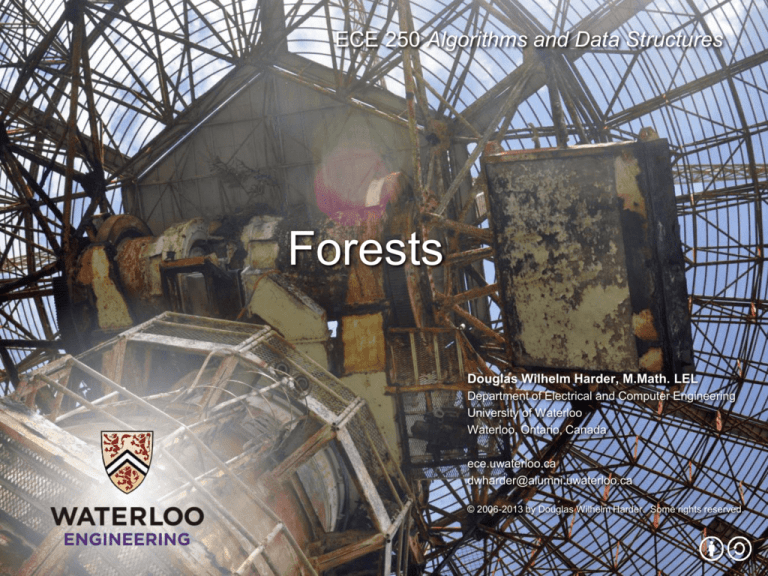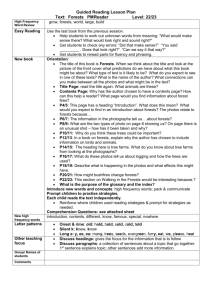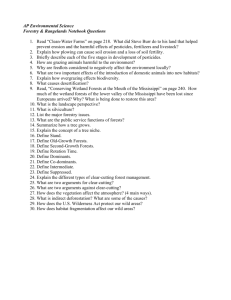
ECE 250 Algorithms and Data Structures
Forests
Douglas Wilhelm Harder, M.Math. LEL
Department of Electrical and Computer Engineering
University of Waterloo
Waterloo, Ontario, Canada
ece.uwaterloo.ca
dwharder@alumni.uwaterloo.ca
© 2006-2013 by Douglas Wilhelm Harder. Some rights reserved.
Forests
2
Outline
This topic covers Prim’s algorithm:
– Finding a minimum spanning tree
– The idea and the algorithm
– An example
Forests
3
Hierarchical relation
Recall the properties of a hierarchical relation:
–
–
–
–
–
It is never true that x ≺ x
If x ≺ y then y ⊀ x
If x ≺ y and y ≺ z, it follows that x ≺ z
There is a root r such that r ≺ x for all x
If is x ≺ z and y ≺ z, it follows that either x ≺ y, x = y or x ≻ y
If we remove the restriction that there is a unique root r, we allow for
the possibility of a number of roots
– If a set S has such a relationship on it, we can define a tree rooted at a
point x as the collection of all y such that x ≺ y
– For a finite set S, there is a set of points R such that for each r ∈ R, there
are no points x ∈ S such that x ≺ r
• We call R the set of roots
Forests
4
Definition
A rooted forest is a data structure that is a collection of disjoint
rooted trees
– A forest can be used to store the previously described relation
Forests
5
Definition
Note that:
– Any tree can be converted into a forest by removing the root node
– Any forest can be converted into a tree by adding a root node that has
the roots of all the trees in the forest as children
Forests
6
Traversals
Traversals on forests can be achieved by treating the roots as
children of a notional root
vk + 1
ek
Forests
7
Traversals
Traversals on forests can be achieved by treating the roots as
children of a notional root
vk + 1
ek
Pre-order traversal:
Post-order traversal:
Breadth-first traversal:
AEBOFPUGHCIQVWJDKRLMSTXYZN
EAO UPFGHBVWQ IJCRKLSXYZTMND
ABCDEFGHIJKLMNOPQRSTUVWXYZ
Forests
8
Implementation
Using the Simple_tree structure, one could simply keep a linked
list of trees
Single_list<Simple_tree *> list;
Using the parental tree structure, one could remove the restriction
that only one entry stores itself
0
1
2
3
4
5
6
7
8
9
10
11
12
13
14
15
16
17
18
19
20
21
22
23
24
25
0 1 2 3 0 1 1 1 2 2 3 3 3 3 5 5 6 10 12 12 15 16 16 19 19 19
A B C D E F G H
I
J K L M N O P Q R S T U V W X Y Z
Forests
9
Application
In Windows, each drive forms the root of its own directory structure
– Each of the directories is hierarchical—that is, a rooted tree
Forests
10
Application
In C++, if you do not use multiple inheritance, the class inheritance
structure is a forest
– In Java and C#, it is a rooted tree with Object being the root class
If you allow multiple inheritance in C++, you have a partial order
– A directed acyclic graph data structure allows you store such a relation
Forests
11
Looking ahead
We will revisit forests with
– The disjoint set data structure
– Graph theory
Forests
12
Summary
In this topic, we defined a forest
–
–
–
–
–
A collection of rooted trees
One less restriction than a hierarchical order
One more restriction than partial orders
Traversals can be defined on forests
Considered two implementations:
• Linked list of simple trees
• A parental tree implementation
– Represents the Windows concept of drives
Forests
13
References
Wikipedia, http://en.wikipedia.org/wiki/Tree_(graph_theory)#forest
These slides are provided for the ECE 250 Algorithms and Data Structures course. The
material in it reflects Douglas W. Harder’s best judgment in light of the information available to
him at the time of preparation. Any reliance on these course slides by any party for any other
purpose are the responsibility of such parties. Douglas W. Harder accepts no responsibility for
damages, if any, suffered by any party as a result of decisions made or actions based on these
course slides for any other purpose than that for which it was intended.







